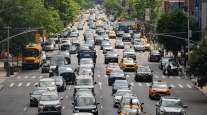New York City Girds for Possible Congestion-Pricing Changes

For New York’s governor and mayor to agree upon anything, it has to be a big deal, so their joint declaration that drivers entering Manhattan’s business core should have to pay a fee probably will change life for its millions of residents and visitors.
Under the plan sketched out Feb. 26, electronic-tolling devices would be installed around the district south of 61st Street by 2020, with discounts for off-peak travel. Uber Technologies Inc. is among those supporting the push for so-called congestion pricing.
“The governor and I have come to an agreement, I think that is a pretty momentous occasion,” Mayor Bill de Blasio said at a news conference in Queens. “And it’s a fair framework for moving forward. The legislative process must be respected, and that’s where details get worked out. But my view is we will get there.”

New York Mayor Bill de Blasio (Jonathan Levinson/Bloomberg News)
Key Step
The agreement is an important step, according to Kathryn Wylde, president of the Partnership for New York City, a civic organization comprising corporate chief executives.
“Nothing is more important to the region’s future economic health than modernizing our transportation system, including elimination of excess traffic congestion,” she said.
Whether big business will lend broad backing is yet to be determined. Representatives for more than a dozen major financial services and media companies and other large employers said they had no immediate comment.
‘Crisis Point’
“Everyone agrees we need a dedicated funding stream to finance the Metropolitan Transportation Authority, but differences arise depending upon where you’re from and who you represent,” said state Senate Deputy Majority Leader Michael Gianaris, who supports congestion pricing. “Suburban members will want their commuter rails improved. People who live in transit deserts will want their constituents protected.”
Though his district lies just across the East River from Manhattan, Gianaris said the commuters he represents ride the subways and know “just how serious the mass transit crisis has become.”
“They know that congestion inside Manhattan has also reached the crisis point,” he said. “Something must be done.”
Congestion pricing, already in place in cities including Singapore and London, has been debated in New York City for decades. More than 10 years ago, then-Mayor Michael Bloomberg proposed charging fees to motorists entering Manhattan to encourage more commuters to use subways and buses. The state Assembly balked at the plan, which Bloomberg said would have raised hundreds of millions of dollars for mass-transit operations and improvements. The former mayor is founder and majority owner of Bloomberg News parent Bloomberg LP.
Cuomo began focusing on the problem in 2017 after months of subway breakdowns, fires and derailments caused frequent delays. The 100-year-old system’s problems result from decades of deferred maintenance and underfunding, and damage to its track and signaling equipment after tunnels were flooded during Superstorm Sandy in 2012. New York Transit Authority President Andy Byford, who is in charge of the city’s subways and buses, has said it would cost $40 billion over 10 years to get the system up to 21st-century standards.
New Taxes
Previous congestion-pricing studies estimated that it could raise about $1 billion a year — based on an $11.52 Manhattan entry fee — to be leveraged into $15 billion through municipal-bond sales for subway improvements. Under the Cuomo-de Blasio agreement, more revenue for the agency would be raised through a new internet sales tax, and a portion of any money derived through taxes on the sale of yet-to-be-legalized marijuana.
Traffic congestion in the central business area is costing the city economy about $20 billion a year, according to a report released in 2018 by the Partnership for New York City.
London introduced its congestion fee in 2003 and now charges vehicles 11.5 pounds ($15.23) for entering a 13-mile zone on weekday commutes. The charge immediately reduced congestion by 30% and traffic by 15%, according to Mayor Sadiq Khan. In recent years, London has seen a major increase in for-hire cars such as Uber and Lyft, which weren’t envisioned when the charge went into affect and don’t have to pay the fee.
Variable Tolling
New York’s system will be different, Cuomo said.
“It has variable tolling, so we can encourage people to drive in non-peak hours,” Cuomo said during a radio interview Feb. 26. “We can encourage deliveries to come in at non-peak hours. And we need to do two things: We need to finance the MTA, but we also need to reduce congestion. It doesn’t matter how well the bus is running if the bus is only going 4 miles an hour.”

Governor Andrew Cuomo (Albin Lohr-Jones/Bloomberg News)
Cuomo said the proliferation of ride services such as Uber and Lyft helped create the congestion. Transit officials say the tens of thousands of for-hire-vehicles also have helped cause a three-year decline in subway ridership, which has deepened the MTA operating deficit to the point where it could reach almost $1 billion by 2022.
Last year, the state Legislature approved a passenger surcharge of $2.50 per cab ride and $2.75 per electronic-hail ride for for-hire-vehicles crossing below 96th Street in an effort to raise about $400 million a year for MTA. The companies are fighting that law in court, and the revenue has been placed in escrow pending the lawsuit’s resolution.
Under the new proposal, subways would be given spending priority for the dedicated revenue generated by congestion pricing. It would be used to install new signaling technology, purchase subway cars, repair tracks and cars, and enhance accessibility.
Meanwhile, Uber and Lyft have been lobbying state officials for the congestion fee, which would impose a once-a-day charge against motorists in the zone.
‘Fair Share’
“We believe that all users of Manhattan’s congested roads — whether it’s a personal vehicle, delivery truck, taxi or Uber — should pay their fair share to keep New York City moving forward,” a spokesman for the company wrote in an e-mail statement.
Cabs and hired-rides, subways and buses are important in New York, where most households aren’t car owners, said Kate Slevin, a senior vice president at the Regional Plan Association.
“New York City is a transit-oriented city,” Slevin said. “Most people are on the subways and buses.”





